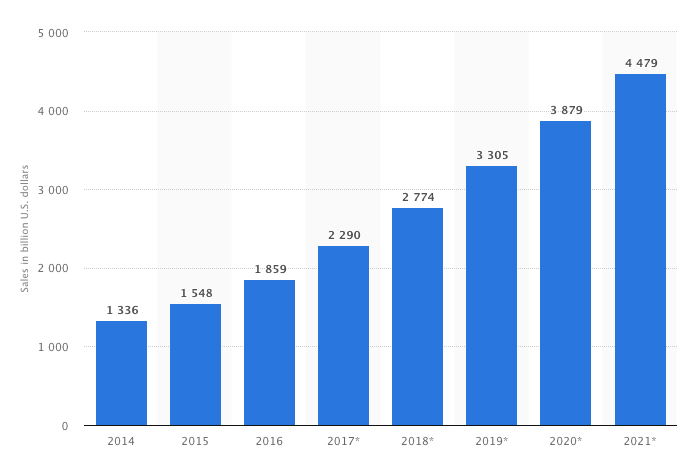
In 2017, online e-commerce sales global amounted to approximately $2.3 trillion US Dollars.

It’s a mindblowing number and that was only the B2C sales, it doesn’t include the B2B wholesale market which has seen a doubling of growth each year since 2003.
Sales are growing at a surprising rate.
In 2018 global retail sales are set to exceed $2.8 trillion according to research provided by statista.
E-commerce Trends 2018
Trends tend to come and go. But the long-term ones are the ones you can use to your advantage as a business owner when planning your marketing for 2018.
Ignore the short-term trends (think fidget spinners) and grab onto the long-term trends (like automation) with both hands.
When predicting e-commerce trends for 2018 we looked at a number of sources:
- Industry experts and their thoughts on where e-commerce is headed
- Popular posts surrounding e-commerce marketing from 2016 and 2017
- New ideas that we’ve noticed people are starting to latch onto
- And finally, we’ve added our own ideas into the mix
There’s a number of e-commerce trends that we think you will be able to take into account when choosing what to focus your marketing on in 2018, but first, let’s look at what trends people predicted in 2017 that we feel are still relevant today that you should be baking into your marketing plans going forward.
Past E-commerce Trends From 2017 To Still Be On Top Of
Just because it’s a new year doesn’t mean that last year’s trends should be thrown out with the bath water.
Many of the past e-commerce trends from 2016 and 2017 are still just as relevant today – or even more so because they’ve become such a core part of a marketer’s toolkit.
Here are three we feel are worth taking note of:
1. Acknowledging & Optimizing For Mobile Traffic
Few trends have had such a big impact as the inevitable drift towards mobile e-commerce.
Instead of creating mobile-specific websites, most smart web developers these days are providing responsive designs for their clients. It’s cheaper to implement and usually results in a better mobile experience anyway.
But don’t just stop there.
You should also be checking how you are communicating with your customers too. Specifically, your emails should be mobile friendly as well to ensure great click-through rates and uptake of offers from mobile recipients.
2. Email Marketing Automation
A trend that has taken the online marketing world by storm in the past few years is email marketing automation.
And I for one am glad that it is here to stay.
Leveraging new-age email marketing platforms like Drip, ConvertKit and even MailChimp (who have had to do a lot of catching up) is very important going forward.
The tagging of customers with actions that they take on and off your website provides an amazing ability to customise marketing campaigns for specific users and user types.
As a store owner, it means that you can be more hands-off, while also appearing to be more hands-on and responsive to your customer’s actions.
3. Email Marketing Personalization
Just because you are automating your emails doesn’t mean they can’t be personalized.
Personalization traditionally has just meant starting your message with “Hi Fred” instead of just “Hi there”.
But the level of personalization we’re talking about here goes beyond that.
Modern email marketing personalization takes the form of monitoring your user’s behaviour. It goes hand in hand with automation because you can set up campaigns to start and finish based on what your customer is actually doing.
Imagine this scenario:
A visitor might come to your site and browse some blog posts. They get triggered by an exit-intent popup to sign up and get a free PDF.
That leads them into a 3-week email sequence talking about why they should buy a certain product.
If they convert on the 1st week, and you are using a modern email marketing system, you can pick up on this and unsubscribe them from that pre-sale sequence and change them over to a post-purchase sequence. That new sequence helps them through the journey of using the product they just bought and asks for a review. After that, if they come back and browse some content related to a different product range to what they currently own, your system can pick up on that and put them on a journey to cross-selling that product too.
Personalization is all about marketing relevance. Providing the right message at the right time.
What You Need To Do In 2018
In 2018 we think there will be a continuation of the above and an overall refinement. The main challenge that awaits in 2018 is making the strategies work harder and finding a focus on what is working.
Here are our top tips for what you need to concentrate on in 2018:
1. Crunch Your Numbers More Frequently
Typically store owners will crunch their numbers yearly or at most quarterly. But going forward that’s not enough for you to react quickly to the ever-changing landscape and demands of customers.
Set yourself up a dashboard that you or a VA can update. It can be as simple as a spreadsheet tracking the core numbers on a monthly or weekly basis (depending on how fast your niche moves).
A dashboard can be super handy for figuring out what is working and what is not in your marketing.
But be aware of which metrics are vanity metrics and which ones actually help you get to your targets.
We have shifted our frequently updated dashboards over to measure exact goal outcomes rather than overall site metrics. This forces us to set measurable goals, then track our progress towards that target on a weekly basis.
2. Talk To Your Customers More
There’s been a growing trend of starting to use AI in the form of chatbots to automate customer communication.
But there’s something to be had by employing dedicated people to monitor live chat and social channels and actually respond to people in a meaningful way.
You just have to look at the responses to a massive outage the communications tool Slack has recently to see what good customer service looks like:
Hugs were distributed evenly. Thanks so much! 😎
— Slack (@SlackHQ) November 1, 2017
There were literally hundreds of customers that wrote in during a bad outage back on November 1st, 2017 and every single one of them had a thoughtful and well-considered reply from a dedicated support agent. You just don’t get this level of sophistication chatbots bots and AI (yet).
Communication is very important and in an age of personalized interactions, it’s only going to continue to grow in importance.
If you can, consider doing some of the following this year:
- Add a live chat to your site and man it 24/7
- Add real reply emails to your email campaigns and actually respond to people’s emails when they reply
- Create surveys to gauge customer sentiment
- Respond to people’s reviews that they leave on your products
- Add some personality to your social channels so people can see that you are real
3. Get Smarter With Your Upsells & Cross Sells
Most people are doing something with upselling products or cross-selling complimentary product lines.
But 2018 is the time to get smarter about those recommendations.
Using marketing automation tools you can monitor people’s past purchases, timing since last purchase, and their browsing behaviour on your website to suggest products that they’re more likely to be interested in. And at a time that is more likely to get them to take action.
If you’re just suggesting the same thing to everyone after the sale, then spending some time adjusting your approach here is going to skyrocket your success levels.
4. Calculate & Focus On Improving Your CLV (Customer Lifetime Value)
Knowing your metrics is going to be super important and the biggest guiding metric of them all that underpins your business is the CLV (Customer Lifetime Value).
The CLV number indicates, on average, how much a customer is worth to you over their lifetime.
An article from Business2Community.com indicates:
“It is six to seven times more expensive to attract a new customer than it is to retain an existing one.”
and
“The probability of selling to an existing customer is up to 14 times higher than the probability of selling to a new customer.”
That means it’s not only cheaper to get your customers to buy from you again, but it’s also 14x easier. I’ll take easier and cheaper any day over hard and expensive.
Increasing CLV is your ticket to higher revenue for the same marketing costs. Putting a focus on this in your marketing team is a smart move for 2018.
5. Get Even More Sophisticated With Your Email Marketing
Testing is critically important when it comes to direct ROI activities such as email marketing. The constant feedback loop is something you can and should take advantage of.
We suggest testing the following in 2018:
- Test plain email templates vs. graphically stylish ones – plain text email tends to get a much higher response rate due to the personal feel of it. It’s great for telling stories, providing information, suggesting up-sells and cross-sells and more.
- Test personalizing subject lines – subject lines are the gateway to customers even opening your emails. A bump in open rates means you get more opportunities to sell.
- Test email triggers based on specific actions – customers viewing certain content multiple times can be a clear indicator that they’re interested in certain types of products. You can also do things like re-capture abandoned shopping carts or make more relevant product recommendations in your newsletters.
Play Your Own Game, Not Someone Else’s
A final note about what to do in 2018. Play your own game.
Everyone’s marketing is different and while it’s nice to analyse and learn from what other people are doing, it’s also important to remember to focus on what is working for you.
Over-analysing trends and success stories and trying to adapt can lead to a choppy marketing approach and that is a high risk in today’s market.
What works for someone else, might not work for you.
Your mantra should be to test and iterate on the things that are working. Focus on what has been working and build on that success.




